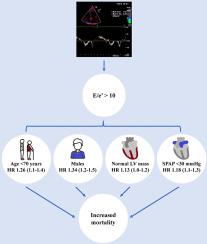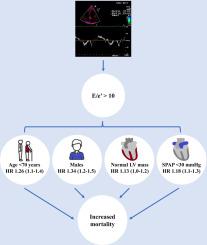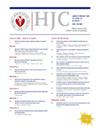Modifiers of the Association between E/e' Ratio and Survival among Patients with No Apparent Structural or Functional Cardiac Abnormality
IF 3
3区 医学
Q2 CARDIAC & CARDIOVASCULAR SYSTEMS
引用次数: 0
Abstract
Background
The ratio between early mitral flow wave to early diastolic mitral annulus velocity (E/e’ ratio) varies according to age and sex and is associated with mortality in heart failure. We sought to describe the association between E/e’ and mortality in patients with no apparent structural or functional cardiac abnormality and explore possible modifiers of this association.
Methods
A retrospective study of 104,315 patients who underwent echocardiographic evaluation during 2009-2021 in the largest tertiary center in Israel. Patients with cancer, ventricular dysfunction, significant valvular or structural heart disease, or evidence of pulmonary hypertension were excluded.
Results
The final analysis included 32,836 patients with a median age of 56 (43-66) years, and 13,547 (41%) were female. The median E/e’ was 8.3 (6.8-10.3), and 9,306 (28%) had an E/e’ >10. During a median follow-up of 5.7 (3.3-8.5) years, 2,396 (7.3%) individuals died. E/e’ >10 was associated with mortality (adjusted hazard ratio [HR] 1.16, 95% confidence interval [CI] 1.07-1.27, p<0.001). The mortality risk associated with E/e’ >10 was significantly higher in those aged ≤70 (HR 1.26, 95% CI 1.12-1.42, p<0.001), males (HR 1.34, 95% CI 1.19-1.49, p<0.001), a normal left ventricular mass (HR 1.13, 95% CI 1.02-1.24, p = 0.017), and pulmonary artery pressure <30 mmHg (HR 1.18, 95% CI 1.06-1.30, p = 0.003).
Conclusion
An elevated E/e’ is associated with mortality, specifically in younger individuals, males, and those with a normal left ventricular mass and lower pulmonary artery pressure. This suggests that an elevated E/e’ might be a marker of subclinical risk in these subgroups. Further studies are needed to identify whether an elevated E/e' is useful in shared decision-making regarding the management of cardiovascular risk factors.


无明显心脏结构或功能异常受试者的 E/e' 比值与存活率之间关系的调节因素
背景E/e'比值因年龄和性别而异,与心力衰竭患者的死亡率有关。我们试图描述E/e'与无明显心脏结构或功能异常者死亡率之间的关系,并探讨这种关系的可能调节因素。方法对2009-2021年间在以色列最大的三级中心接受超声心动图评估的104315人进行回顾性研究。结果最终分析包括 32836 名患者,中位年龄为 56 岁(43-66 岁),其中女性 13547 人(41%)。中位 E/e' 为 8.3(6.8-10.3),9306 人(28%)的 E/e' 为 10。在中位数为 5.7(3.3-8.5)年的随访期间,有 2396 人(7.3%)死亡。E/e' >10与死亡率有关(调整后HR为1.16,95%CI为1.07-1.27,p<0.001)。年龄≤70 岁(HR 1.26,95%CI 1.12-1.42,p<0.001)、男性(HR 1.34,95%CI 1.19-1.49,p<0.001)、左心室质量正常(HR 1.13,95%CI 1.02-1.24,p=0.结论 E/e'升高与死亡率有关,特别是在年轻人、男性、左心室质量正常和肺动脉压力较低的人群中。这表明,在这些亚组中,E/e'升高可能是亚临床风险的标志。还需要进一步研究,以确定升高的 E/e'是否有助于心血管风险因素管理的共同决策。
本文章由计算机程序翻译,如有差异,请以英文原文为准。
求助全文
约1分钟内获得全文
求助全文
来源期刊

Hellenic Journal of Cardiology
CARDIAC & CARDIOVASCULAR SYSTEMS-
CiteScore
4.90
自引率
7.30%
发文量
86
审稿时长
56 days
期刊介绍:
The Hellenic Journal of Cardiology (International Edition, ISSN 1109-9666) is the official journal of the Hellenic Society of Cardiology and aims to publish high-quality articles on all aspects of cardiovascular medicine. A primary goal is to publish in each issue a number of original articles related to clinical and basic research. Many of these will be accompanied by invited editorial comments.
Hot topics, such as molecular cardiology, and innovative cardiac imaging and electrophysiological mapping techniques, will appear frequently in the journal in the form of invited expert articles or special reports. The Editorial Committee also attaches great importance to subjects related to continuing medical education, the implementation of guidelines and cost effectiveness in cardiology.
 求助内容:
求助内容: 应助结果提醒方式:
应助结果提醒方式:


